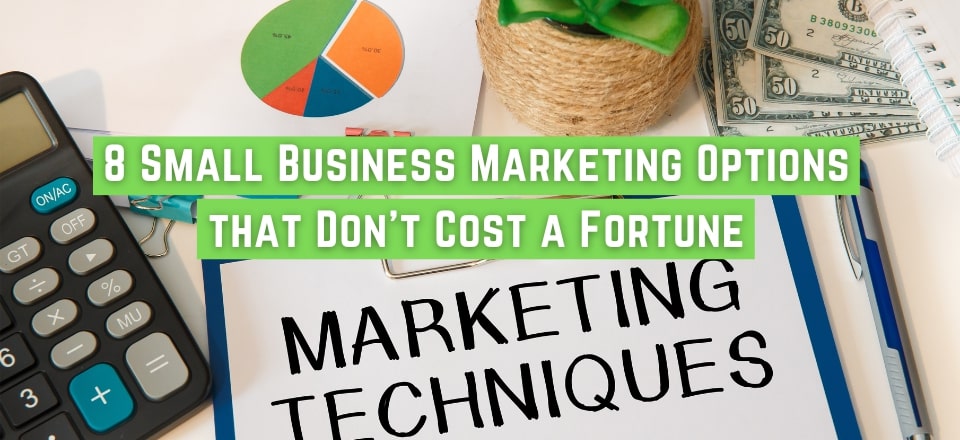If you’re running a small business in 2025, you already know the challenges. Interest rates have been volatile for three years. The cost-of-living crisis continues to squeeze consumer spending. And let’s not even start on how AI disruption has changed the competitive landscape.
The natural response? Cut costs wherever possible—and marketing budgets are often first on the chopping block. But here’s the thing: reducing your marketing visibility now could mean losing ground you’ll struggle to recover when conditions improve.
This guide covers eight proven marketing strategies that deliver results without the hefty price tag of paid advertising. Whether you’re bootstrapping a startup or managing an established business through tough times, these approaches work.
The Reality of Small Business Marketing
Most small to medium businesses face the same challenges: limited marketing expertise and tight budgets that can’t compete with major brands’ advertising spend.
Sound familiar? Here are eight practical strategies to maintain strong marketing results without needing an in-house marketing team—and without burning through cash on expensive ad campaigns.
1. Build Your Business Website
A business website isn’t optional anymore. It’s the foundation for nearly every other marketing activity you’ll undertake. Without one, you’re essentially invisible to the 5.4 billion people now using the internet globally.
Think about this: thirty years ago, businesses needed physical storefronts or offices to establish credibility. Today, your website serves that purpose more effectively and at a fraction of the cost. It works 24/7, reaches customers anywhere, and never takes a sick day.
Making It Happen Without Breaking the Bank
Worried about costs? You’ve got options. Platforms like WordPress or Squarespace let you build professional sites without coding knowledge. Monthly costs start around $20-30 AUD.
If you want a more polished result, consider hiring a virtual assistant with web development skills. VAs from the Philippines typically charge $8-15 AUD per hour for this work—significantly less than the $75-150 per hour Australian web designers charge. Virtual Done Well can connect you with pre-vetted developers who understand Australian business needs.
2. Perfect Your Elevator Pitch
An elevator pitch remains one of the most underutilised marketing tools. It’s your 60-90 second explanation of what your business does and why it matters. No rambling, no jargon—just clear value.
You’ll use this everywhere: networking events, chance meetings, video calls, even your email signature. The beauty? It costs nothing to develop and delivers results every time you use it.
Where Your Pitch Pays Off
Don’t wait for opportunities to present your pitch. Actively seek them out:
- Industry associations and professional bodies
- Trade shows and exhibitions (Australia hosts over 500 annually)
- Local business chambers and networking groups
- Online forums and virtual meetups
- LinkedIn conversations and comments
Each interaction is a potential customer or referral source. Make them count.
3. Start Business Blogging
Business blogging drives organic traffic to your website without ongoing advertising costs. It’s particularly effective in 2025, as Google’s latest algorithm updates favour helpful, expertise-based content over keyword-stuffed pages.
Regular blog posts establish you as an industry authority. When potential customers search for solutions you provide, your content appears in their search results. They arrive seeking information and discover a business that can solve their problems.
Getting Quality Content Without Writing It Yourself
Creating effective blog content requires specific skills: writing ability, SEO knowledge, and industry expertise. If that’s not your strength, virtual assistants specialising in content creation can handle this for you.
Filipino VAs with strong English skills and SEO training typically charge $10-20 AUD per hour for blog writing. That’s roughly the cost of one sponsored Facebook post, but the blog content keeps working for years. At Virtual Done Well, we match businesses with content creators who understand both Australian markets and international SEO best practices.
4. Ask for Customer Referrals
Word-of-mouth marketing has been around forever because it works. In 2025, with trust in paid advertising at an all-time low, personal recommendations matter more than ever. Studies show 92% of consumers trust referrals from people they know.
Here’s what most businesses miss: satisfied customers will refer you, but only if you ask. They’re busy. They forget. Make it easy for them.
Making Referral Requests Work
Asking face-to-face delivers the best results, but if that feels uncomfortable, you have alternatives:
- Add a referral request to your invoice footer
- Include it in your email signature
- Send a follow-up email after successful project completion
- Create a simple referral program with basic incentives
- Add a referral section to your website
The key is consistency. Make requesting referrals part of your standard process, not an afterthought.
5. Create Digital Brochures and Flyers
Digital brochures work harder than their paper ancestors. Create them once, then distribute them thousands of times at virtually no cost. Email them, share them on social media, embed them on your website, or print small batches as needed.
Canva offers thousands of professional templates. Even the free version provides enough options for most small businesses. If design isn’t your thing, a virtual assistant with graphic design skills can create professional materials for around $15-25 AUD per hour.
Distribution Strategies That Work
- Add downloadable brochures to your website
- Include them in email campaigns
- Share in relevant Facebook groups
- Attach to LinkedIn messages
- Leave printed copies at complementary businesses
- Include QR codes linking to digital versions
6. Leverage Social Media Groups
Facebook groups and LinkedIn communities offer direct access to your target market. As of 2025, Facebook hosts over 3 billion active users, with most belonging to multiple groups. LinkedIn has 1 billion members, with engagement in professional groups at record highs.
The trick isn’t just joining groups—it’s contributing valuable insights without being salesy. Share your expertise, answer questions, and build relationships. Sales come naturally when people trust your knowledge.
Finding and Using the Right Groups
Search for groups using keywords your customers would use. A plumber might join home renovation groups. An accountant might participate in small business forums. Look for:
- Active daily discussions
- Membership of 1,000+ people
- Clear rules against spam
- Members who match your customer profile
Once established in these groups, consider starting your own. A Facebook group you control becomes a direct line to engaged prospects.
7. Create Video Content
Video content isn’t optional anymore. YouTube remains the world’s second-largest search engine, while short-form video dominates social media engagement. TikTok, Instagram Reels, and YouTube Shorts collectively generate billions of daily views.
You don’t need expensive equipment. Modern smartphones shoot 4K video. Free editing software like DaVinci Resolve rivals professional tools. The barrier isn’t technology—it’s taking the first step.
Video Content That Converts
- How-to tutorials solving common problems
- Behind-the-scenes glimpses of your business
- Customer testimonials and case studies
- Quick tips related to your industry
- Product demonstrations and comparisons
- Live Q&A sessions
If you’re camera-shy, virtual assistants skilled in video editing can create professional content using stock footage, animations, and voiceovers. Rates typically run $15-30 AUD per hour for this specialized work.
8. Partner with Micro-Influencers
Forget celebrity endorsements. Micro-influencers—people with 1,000 to 100,000 engaged followers—deliver better ROI for small businesses. They charge less, have higher engagement rates, and their recommendations feel more authentic.
In 2025, micro-influencer marketing has matured. These creators understand their value but remain accessible to small businesses. Many will review products for free samples or modest fees ($100-500 per post).
Finding the Right Influencers
- Search hashtags relevant to your industry
- Check who’s actively commenting on competitor posts
- Look for local influencers in your area
- Use platforms like TRIBE or Scrunch
- Monitor who’s already mentioning your brand
Remember: follower count matters less than engagement. An influencer with 5,000 engaged followers beats one with 50,000 passive ones.
The Trade-Off: Time vs Money
These low-budget marketing strategies work, but they demand time and consistency. You’re trading expensive advertising costs for effort and persistence.
That’s where virtual assistants become invaluable. Instead of hiring full-time marketing staff at $60,000-80,000 annually, you can work with skilled VAs for a fraction of that cost. They handle the time-consuming tasks while you focus on running your business.
Getting Started with Virtual Marketing Support
At Virtual Done Well, we match Australian businesses with skilled virtual assistants who understand both local market needs and international best practices. Our VAs handle everything from content creation and social media management to website updates and email campaigns. Contact Virtual Done Well to learn more or get started.
Many of our clients work with virtual assistants who split their time between marketing tasks and general administration. It’s a flexible, cost-effective approach that scales with your business.
The marketing landscape in 2025 rewards businesses that provide value over those that simply advertise loudest. These eight strategies help you build genuine connections with customers without the crushing costs of paid advertising.
Ready to amplify your marketing without amplifying your costs? Contact Virtual Done Well today. Let’s discuss how our virtual assistants can help you implement these strategies and grow your business in 2025.



Recent Comments